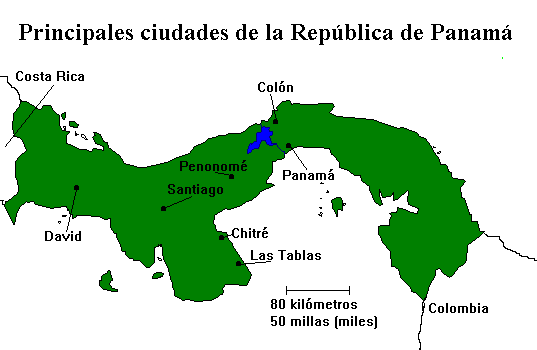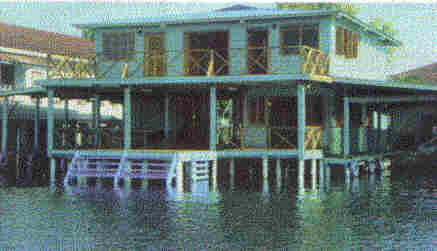Visit to Panama

Panama has a extention of 28,432 square miles. It has 468 miles of coast
at the Caribean Sea and 750 miles of coast at the Pacific Ocean.
For many the big discovery is the shopping. For latins, Panama provides
the finest shopping center south of Miami. For many the discovery could
be the casinos, the Atrlantic or Pacific Ocean activities, the mountanins,
the girls, the jungle, the fishing and the Panama Canal.
In this brief introduction, 2000 year statistics show a population of 2.8
milions people of diverse origins. Descendants of Apanish settlers,
of the black Cimarrones, Indians of coast and mountains, North Americans,
emigre families of European stock, Chinese and East Indians.
Panama have less than 50 miles from North to South in the narrow site
(near the Panama Canal). Panama has 477 miles of Caribbean coastline and
767 miles of Pacific Beaches. At sea-level the temperature is around
90 degrees Farenheith. We talk of "dry season" approximately between the
months of December to April, and from May to November we have rainy season.
CURRENCY

The currency is the Balboa, is at par with the US dollar. Coinage is
Panamanian and is equivalent with US currency coins which is of the
same size, value and slot machine acceptance. Panama don't have paper
currency and use the US Dollar.
HISTORIC FACTS
COLONIAL PANAMA: Old Panama, Portobelo and Fort San Lorenzo are tolerating
tourist camaras and flashes with serene equanimity. Sir Henry Morgan and
Francis Drake was pirates during the traveling of gold and silver from
Bolivia and Peru lay heaped in the streets of Portobelo, waiting the
teasure fleet to Spain.
CASCO VIEJO OF PANAMA: New Orleans South, minus Basin Street. The balconied,
narrow-streeted Cold Compound, so named for having once been behind the
city wall, shares the mixed Spanish and French heritage of New Orleans.
The French Connection, in this case, was Ferdinand de Lesseps attempt
to repear the France's Suez at the first try to construct a Canal.
ACTUAL PANAMA
LAS VEGAS PANAMA: The principal tourist hotels have casinos. The other
hotels are within dice-throw of these casinos. If they had been in operation
when Morgan travelled here,, he could have gotten his money without
burning the place down.
SHOPPING CENTER PANAMA: A trading post is what the Isthmus has always
been. The point about being the shortest crossing between the Atlantic
and the Pacific commerce shall use the route. Hence Panama City's
Central Avenue, Colon's Free Zone, the newser shopping sectors around the
hotels, the huge shopping plazas on the road to the airport, and Tocumen
Airport's duty-free stores.
ISLANDS OF PANAMA

The Pearl Islands, San Blas Islands, Taboga, Coiba, Bocas
del Toro (Bull Mouths); all are different. contadora, one of the Pearl
Islands is a sun-and-sea resort.
BEACHES PANAMA
The pacific beaches are choice of glisterning white
sand and sparklink black sand. Bast acres of it for swimming, surfing,
running or jogging.
BOCAS DEL TORO

The origin of the name of Bocas del Toro (Bull Mouths) is shrouded in
mystery. Some say that it was coined by Christopher Columbus on his fourth
and final voyage to the New World in 1502, when he saw a waterfall with
the relevant shape. Others claim the name comes from a local indian chief
called Boka de Toro.
By 1899, the economy and culture of Bocas centered around the United
Fruit Company (later known as the Chiriqui Land Company). The banana
trade was lucrative and serving it was a thriving, populous city which
attracted Afro-Antillean workers from Jamaica and later from the Panama
Canal venture.
Then a banana disease ravaged the plantations so they were moved to the
Changuinola region on the nearby mainland. As a result, the economy of
Bocas declined and the cheerful, "gengerbread", Georgian houses began
fall into desrepair. That was to be ecoturism as this industry has boomed
in the 90's. Panama's Caribbean jewel has been recognized as a prime
tourist destination.
PANAMA CITY
Panama City earns its bobrequet "Crossfoads of the World". The fact that
so many people pass this way, and so many pause awhile, gives this latin
city a uniquely international feeling.
The city has a population of about a million people. The name Panama
comes from an Indian word meaning "an abundance of fish". Panama city
has been called a melting pot.
Criollos, Iberian-descended Panamanians, as proud of their ancestry as
New Englanders are flattered at being called English. Mestizos, the
Criollo-Indian blend that is the non-silent majority in most of Latin
America. Blacks whose fathers signed on in the then-British West Indies
to dig the Canal.
PANAMA CITY AT DAYLIFE
Panama receives visitors from the world around, and sells products from
the world around, many at duty-free prices. Somewhere along the line,
a tourist is going to find himself wondering why he came all this way
to buy something from the old home town. After shopping, tourist can
visit the Panama Canal.
PANAMA CITY AT NIGHTLIFE

Panama casinos, restaurants, discotheques, bars and floorshows. The
rhythm of tropic tamborito new has competition as Panama's night sound,
from the carillon-pealing of slot machines.
There are restautants of a dozen culinary allegiances. You can even
choose between Peking, Tokyo of Seoul.
PORTOBELO
Is about an hour and 20 minutes unless you stop off for a
swim at the Maria Chiquita beach which has changing facilities or Playa
Langosta.
From its commercial demise when the isthmus became independent from
Spain in 1821, until a few years ago, Portobelo, the Spanish Main's
richest teasure port, mouldered, a roadless fishing village with an
annual flicker of life for the Block Christ of Portobelo celebration
each year by October 21 at the Portobelo Cathedral.
FORT SAN LORENZO
Is about and hour's drive unless you have to make way
for a container ship. The road crosses atop the Gatun lock gates. The
locks and the spillway on Gatun Dam make a spectacular sight-seeing
stop, in any case.
This bastion is near the canal at the mouth of the Chagres River, once
the highly strategic key to the route across the isthmus. Pirate Henry
Morgan sorted out its secrets after his own pragmatic fashion enroute
to Panama City. He managed to discover the deficiencies of the defences,
which, however, are clear to a Pentagon-wise tactician today.
THE CENTRAL PROVINCES
The "Central Provinces of Panama" include the provinces of Cocle, Herrera,
Los Santos and Veraguas. They are situaded to the west of Panama City along
the Pan-American Highway.
Their main attraction is their culture. A region of quaint little towns,
history and strong religious beliefs, their relative isolation from Panama
City during the colonial period contributed to the strenght of their
Hispanic Traditions.
The city of Penonomé, capital of Coclé province can serve as a center from
which visitors can discover some interesting sites, including the town
of La Pintada, known for the famous "Sombrero Pintado" hats, which are
an important element of the owr national costume for men.
Other attractions are the archaeological museums of Sitio Conte and
El Canño, where skeletal remains and tools dating from the pre-columbian
period are displayed. the museums are located between Penonome and the
town of Natá, which is the oldest city in the interior of Panama founded
by 1522.
Azuero Peninsula is the next stop in the trip to the west of Panama. The
Azuero Peninsula comprising the provinces of Herrera and Los Santos. That
region if famous for its festive spirit, which year after year attracts
thousands of city folk during the famous Carnival celebrations in Chitré
(capital of Herrera province) and Las Tablas (capital of Los Santos). The
"Pollera" is the national dress of women, and the "Pollera" is original
from Guararé (10 miles from Las Tablas).
Herrera province has a desert, Sarigua National Park, a 8000 hectare of
arid coastal plain. The region is also known for its fine pottery, which
can be found in La Arena (a city 3 miles from Chitre). Small but interesting
museums in these towns cover verything from the pre-columbian period
to the role of both provinces in the Panama's independence struggle.
Leaving the peninsula and striking western once again, brings the traveller
to Veraguas, the only province with coast on both oceans. From its capital
Santiago, visitors can venture aout to the Gulf of Montijo, and from there,
to the fishing meccas of Leones, Cebaco, Gobernadores and Coiba on the
Pacific Ocean. The province also offers magestic mountain scenary.
CHIRIQUI

For thouse interested in any of the following, Chiriqui is the place to
find them: flower growing, trout fishing, medicinal springs, alpine farms,
coffee, beer tasting, orange growing, cattle ranches, birdwatching, etc.
David is the third important city of the Republic of Panama. David is the
capital of the Chiriqui province. Most sightseeing spectacles are within
easy range of here, but a number of alluring mountain hotels can be found
in the cooler climate of Boquete and Volcan.
Boquete is the nation's flower garden, prime supplier for the capital
city's florist.
Chill streams founding down from the Volcan Barú (11,450 feet over the sea).
Boquete, Cerro Punta or Volcan City contain a caveat for those who believe
corvina reigns unchallenged as Panama's tastiest fish.

In Volcan's lakes you can fish for mountain trout in the orthodox manner.
In some of volcan's hotels you can deploy your rod from the bedroom window.
Hot sulfurous springs can be found at Boquete, Bugaba, David, Gualaca.
The tigh farms of Chiriqui look swiss in their greenness and husbandry.
Homes on the slopes yodel swiss chalet architecture. Unsurprising perhaps,
since a swiss farming colony arrived there years before the first road.
Following them were Yugoslav farmers.
Oranges, grapes, strawberry and vegetables are grown in Cerro Punta and
Volcan city. Birdwatchers will find almost 1000 species along the Chiriqui
border with Costa Rica. Distinguished residents include the quetzal, who
sets Chiriqui as shis southers-most abode.
SAN BLAS ISLANDS
 The San Blas woman wears as everyday dress, her appliqued Mola blouse,
gold rings, long skirt, red and yellow headdress and beads of gold ornaments
at neck, arm and ankle.
The San Blas woman wears as everyday dress, her appliqued Mola blouse,
gold rings, long skirt, red and yellow headdress and beads of gold ornaments
at neck, arm and ankle.
The San Blas islands stretch along approximately 200 miles of Panama's
Cariggean coastline and San Blas territory is defined from the seaward
continental shelf to the top of the jungle-clad continental divide some
miles inland.
Within this territory, the Kuna Indians, are short, stocky people of great
simplicity and charm whose ancestors peopled these shores long before
Columbus landed, govern themselves in a virtually autonomous society.
Every day, Indian women and children literally "commute" from their
village islands to the mainland in their dugout canoes or cayucos to wash
and play in the river.
The men either go to the mainland to cultivate corn, yucca and coconuts,
or go fishing or trading around neighbouring islands. No land is individually
owned in San Blas, but the coconut trees are. Any disputes are settled within
the village itself, and each village has its congress hall, a large hut
where the people make their decisions.
There is a Goverment outpost and a Fuerza Publica station on the island
of Porvenir but the Police Force doesn't do much business. The Indians
deal with their own problems and their own people.
For all the simplicity of their lives the San Blas Indians remain very aware
of their rights to their own territory and they guard their rights pasionately.
Return to Main Menu
(C)opywrite Ing. Jose Agustin Rodriguez
E-Mail: ponzada@yahoo.com







 The San Blas woman wears as everyday dress, her appliqued Mola blouse,
gold rings, long skirt, red and yellow headdress and beads of gold ornaments
at neck, arm and ankle.
The San Blas woman wears as everyday dress, her appliqued Mola blouse,
gold rings, long skirt, red and yellow headdress and beads of gold ornaments
at neck, arm and ankle.